The ocean is home to an incredibly diverse range of creatures, with estimates suggesting that there may be millions of marine species yet to be discovered and classified. Of course, not all sea creatures that have come to be are still in existence. There are many reasons why certain sea creatures have gone extinct throughout history. Natural events such as geological shifts, volcanic eruptions, and changes in ocean currents and temperatures have all played a role in the extinction of many marine organisms, particularly during mass extinction events.
Human activities, such as overfishing, pollution, and habitat destruction, have also caused many species to go extinct in recent times. For example, many species of sea turtles have been pushed to the brink of extinction due to bycatch in fishing gear, habitat loss, and poaching.
Furthermore, climate change is becoming an increasingly pressing threat to marine life as ocean temperatures rise and ocean chemistry shifts. This can affect everything from the distribution and abundance of prey species to the ability of ocean organisms to form shells or skeletons.
In this article, we are going to explore 10 extinct sea creatures!
1. Ammonites
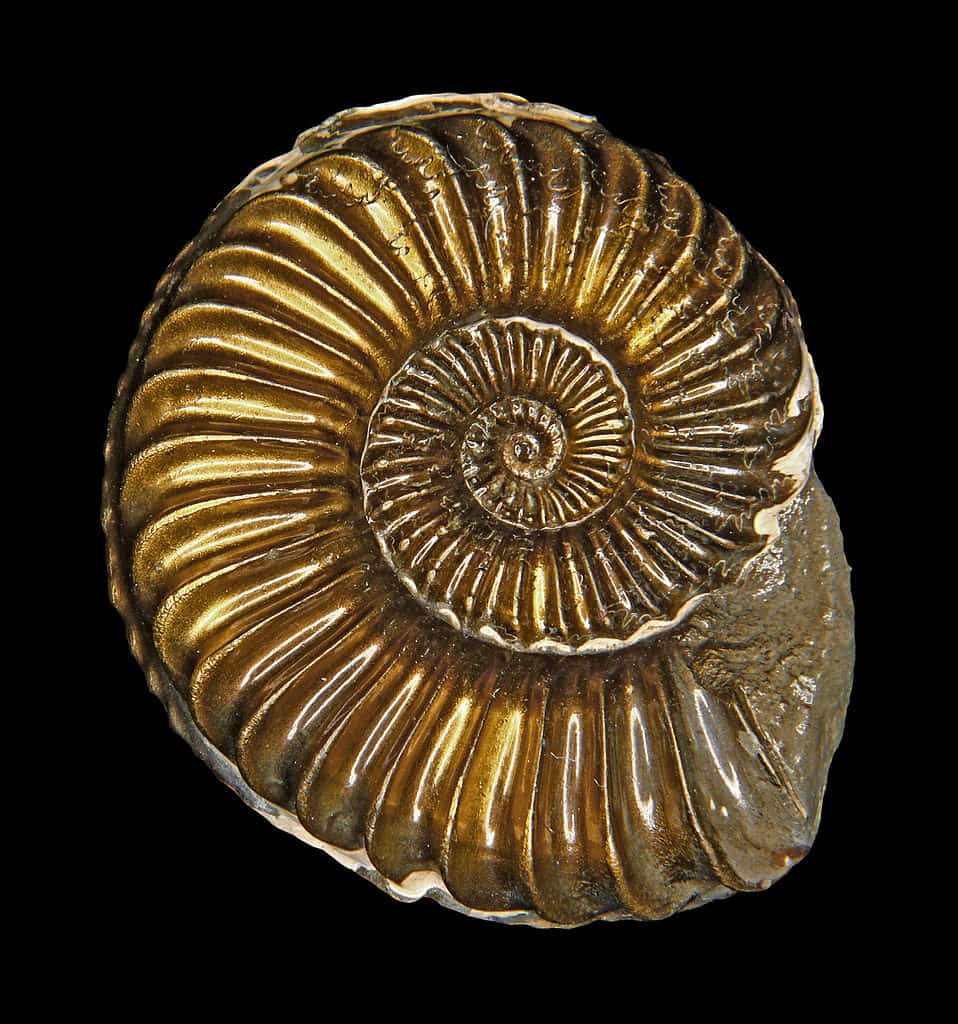
©Llez (H. Zell) / CC BY-SA 3.0 – License
Ammonites are extinct marine mollusks that lived between 240 and 65 million years ago. They are known for their distinctive spiral shape with ridges and distinctive patterns on their shells.
Ammonites are cephalopods with soft, squid-like bodies and hard shells that served as protection from predators. They lived in shallow seas and ranged in size from less than an inch to more than 3 feet in diameter.
The name “ammonite” comes from the spiral shape of their shells, which resembles the horns of the ancient Egyptian god Ammon.
Ammonites are important fossils studied by paleontologists because they can help determine the age of the rock layers in which they are found. Their shells can also provide information about the ancient marine environment, such as water temperature and oxygen levels.
Ammonites became extinct along with the dinosaurs about 65 million years ago, but their descendants include modern-day cephalopods such as squids, octopuses, and nautiluses.
2. Mosasaurs
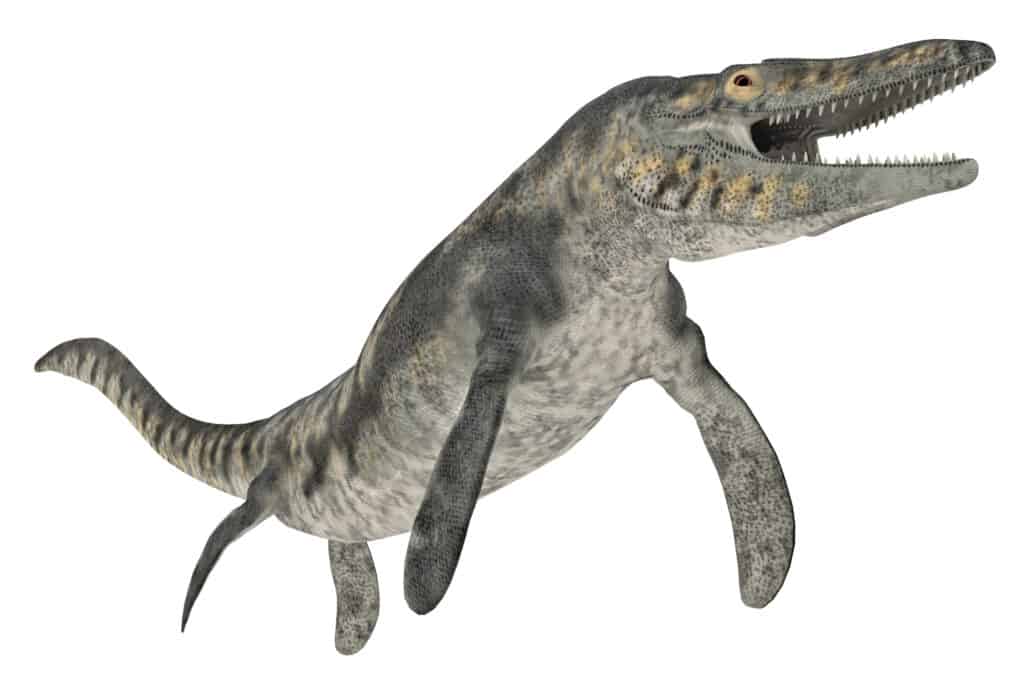
Mosasaurs, now extinct, were a large marine reptiles from the Late Cretaceous.
©iStock.com/MR1805
Mosasaurs were a group of large, carnivorous marine reptiles that lived during the Late Cretaceous period, approximately 70 to 66 million years ago. They were among the top predators of their time and were famous for their long, streamlined bodies, powerful jaws, sharp teeth, and paddle-like limbs that allowed them to swim swiftly through the water.
Mosasaurs ranged in size from small, six-foot-long species to giant creatures that measured up to 50 feet in length. They had a variety of adaptations that made them well-suited for life in the water, such as a long, muscular tail for propulsion, powerful jaws capable of crushing prey, and a flexible neck that allowed them to swallow large prey whole.
Mosasaurs were widespread and diverse, with species found in all major oceans of the world. They preyed on a variety of marine creatures, including fish, squid, turtles, and even other mosasaurs. Evidence suggests that some species of mosasaurs may have come ashore to lay their eggs, much like modern-day sea turtles.
Despite their impressive size and ferocious reputation, mosasaurs went extinct along with the dinosaurs at the end of the Cretaceous period, likely due to a combination of factors including climate change and the impact of a massive asteroid.
3. Ichthyosaurs
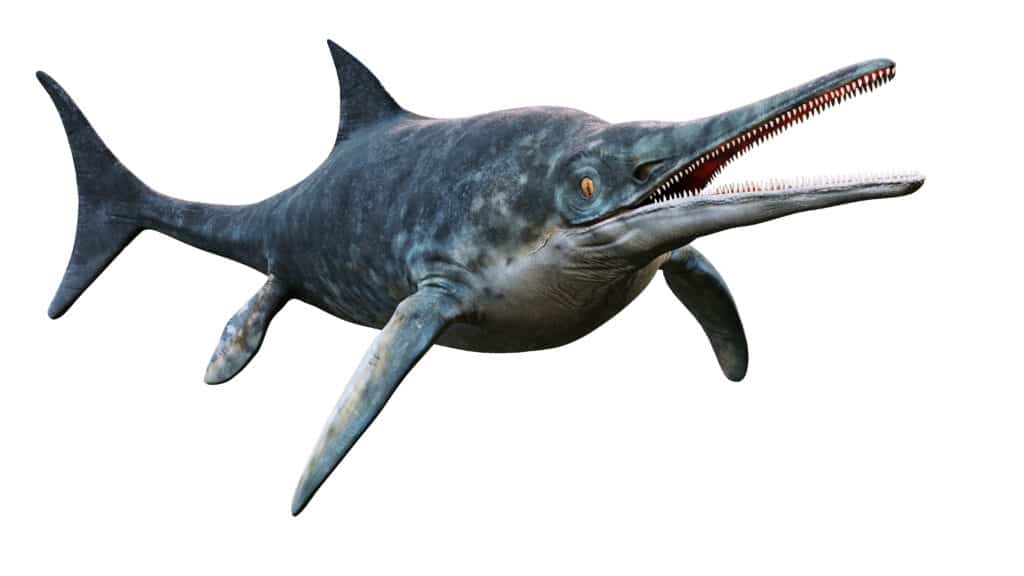
Ichthyosaurs were a group of marine reptiles that lived during the Mesozoic Era, around 250-90 million years ago. They were adapted for a fully aquatic lifestyle, with streamlined bodies, powerful tail fins, and four flippers for efficient swimming.
Ichthyosaurs varied in size, from small and agile species just a few feet long, to giants up to 50 feet in length. Some had elongated snouts like a dolphin, while others had shorter, broader jaws like a crocodile.
Ichthyosaurs were one of the dominant predators in the Mesozoic oceans and fed on a variety of prey including fish, squid, and other marine reptiles. They were an important part of the marine ecosystem for millions of years, before eventually going extinct around 90 million years ago, possibly due to competition from other marine reptiles or changing ocean conditions.
4. Steller’s Sea Cow

Stellers Sea Cow
©Nicolas Primola/Shutterstock.com
Steller’s sea cow was a large marine mammal that went extinct in the 18th century. They were an important source of food for the indigenous people of the Bering Sea region, but their population declined rapidly following the arrival of Russian fur traders in the 1700s. Steller’s sea cows were related to manatees and dugongs, but were much larger, reaching up to 30 feet in length and weighing over 11,000 pounds.
They were named after the German naturalist Georg Wilhelm Steller, who first described them in detail during the Great Northern Expedition of 1741. Steller observed that their skin was thick and tough and that they had no teeth for grinding food. Instead, they used tough lips and a grinding pad in their mouths to chew the kelp and other plants that they ate.
Despite their immense size, Steller’s sea cows were docile and slow-moving, which made them easy targets for hunters. They were hunted extensively for their meat, fat, and hides, and their population declined rapidly from an estimated 2,000 individuals to just a few hundred within a few decades. By 1768, they were extinct, just 27 years after they were first discovered.
Today, Steller’s sea cow serves as a cautionary tale about the impact of human activities on the natural world. It is a reminder of the importance of conservation efforts to protect endangered and threatened species, as well as the need to be mindful of our impact on the environment.
5. Dunkleosteus
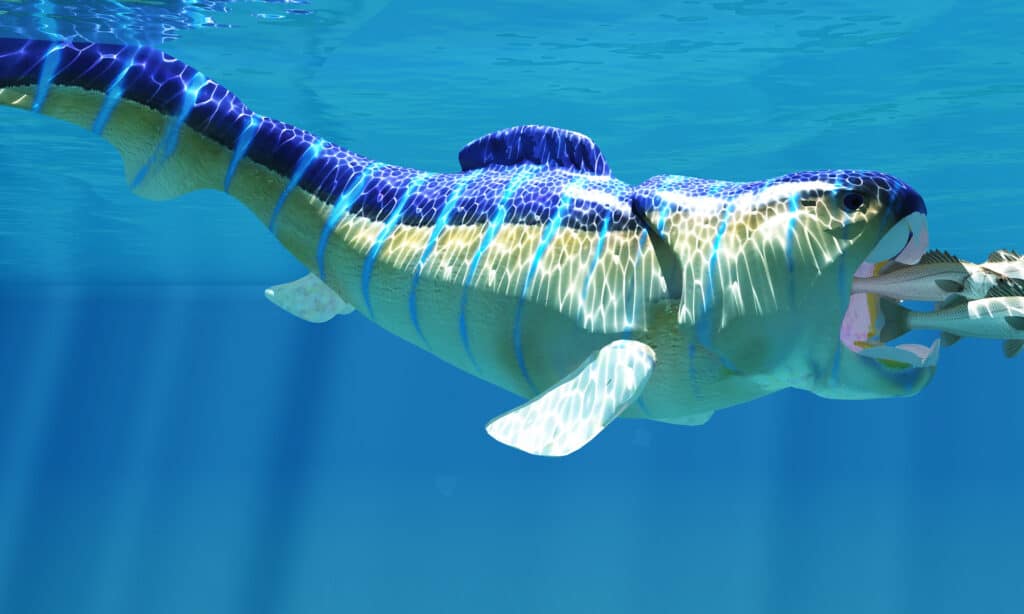
Dunkleosteus had strong jaws that could chop up sharks and other marine creatures.
©Catmando/Shutterstock.com
Dunkleosteus is an extinct genus of prehistoric fish that lived during the Late Devonian period, around 360 million years ago. It was one of the largest creatures of its time, measuring up to 10 meters (33 feet) in length and weighing up to 4 tons.
Dunkleosteus had a heavily armored head and jaws, which it used to crush and slice its prey with sharp bony plates. Its head was also equipped with two sets of sharp cutting teeth, which could move independently to grip its prey.
The rest of Dunkleosteus’s body was mostly soft, and covered with small scales and fins that were used for propulsion. It is believed that Dunkleosteus swam near the ocean floor, where it preyed on other fish, sharks, and even small marine animals like nautiloids.
Despite its fearsome appearance, Dunkleosteus was an efficient swimmer and did not have any natural predators. Its extinction is thought to have been caused by a combination of factors, including climate change and competition for food resources. Today, Dunkleosteus remains a fascinating specimen for paleontologists to study and has become a popular subject in popular culture.
6. Helicoprion

Helicoprion bessonovi was a shark-like fish from Early Permian. The Helicoprion had a whorl of teeth embedded in its lower jaw.
© – License
Helicoprion is an extinct genus of shark-like fish that lived during the Late Carboniferous to Early Triassic periods, approximately 290 to 250 million years ago. It is also known as the “buzzsaw shark” due to its unusual whorl-shaped tooth structure.
The distinctive teeth of Helicoprion are found as spirals in fossils, which were originally thought to be part of its dorsal fin or tail. However, later studies showed that these teeth were actually part of its lower jaw. The teeth were curved spirally and formed a continuous symmetrical whorl, which is thought to have been used for catching and slicing through prey, such as ammonites and other invertebrates.
Despite being a common fossil, the exact body shape and habits of Helicoprion remain poorly understood, and many aspects of its biology and behavior are the subject of ongoing research and debate.
7. Pliosaurus
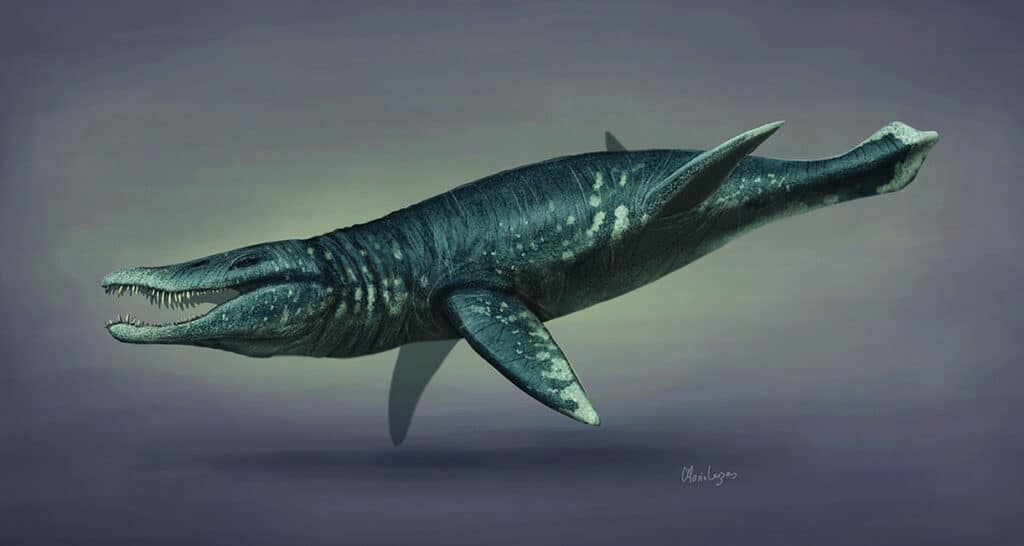
Pliosaurus
©Mario Lanzas, CC BY-SA 4.0, via Wikimedia Commons – License
Pliosaurs were a group of large aquatic reptiles that lived during the Jurassic and Cretaceous periods, about 160 to 70 million years ago. They were part of the larger group of marine reptiles known as plesiosaurs.
The Pliosaurus had a distinctive body shape, with a large, elongated head, short neck, and massive body. They were apex predators and had powerful jaws filled with sharp teeth that they used to hunt fish and other marine animals. Some species of pliosaurs, such as Kronosaurus, grew up to 30 feet long and weighed several tons.
Pliosaurs evolved to be more adapted to the marine environment than their plesiosaur cousins, with shorter necks and more robust bodies. They were also able to move much faster than plesiosaurs, with some species capable of reaching speeds of up to 20 miles per hour.
Unfortunately, like many other prehistoric creatures, pliosaurs eventually became extinct. The exact cause of their extinction is not known, but it is believed to be a combination of environmental factors, such as climate change, and competition with other marine predators.
8. Trilobites

©iStock.com/Aunt_Spray
Trilobites were a diverse group of extinct marine arthropods that lived from the Cambrian period to the end of the Permian period, approximately 521 million to 252 million years ago. They are one of the earliest known groups of arthropods and were some of the most successful animals of their time, with over 20,000 described species.
Trilobites were characterized by their distinctive three-lobed, segmented body and hard exoskeleton. They ranged in size from less than a millimeter to over two feet long. Most trilobites had compound eyes, which could be very complex and were often highly adapted to different environments. They also had a pair of long, multisegmented antennae used for sensing their environment and finding food.
Trilobites lived in a variety of marine environments, from shallow waters to deep oceans. They were essential predators and prey, and some species were filter-feeders, while others lived on the sea floor and scavenged for food.
The last trilobites disappeared during the Permian mass extinction, which occurred around 252 million years ago. Today, trilobites are valuable to scientists and collectors because they provide important data on the evolution of life on Earth and the ancient environments in which they lived.
9. Sea Scorpions (Eurypterids)
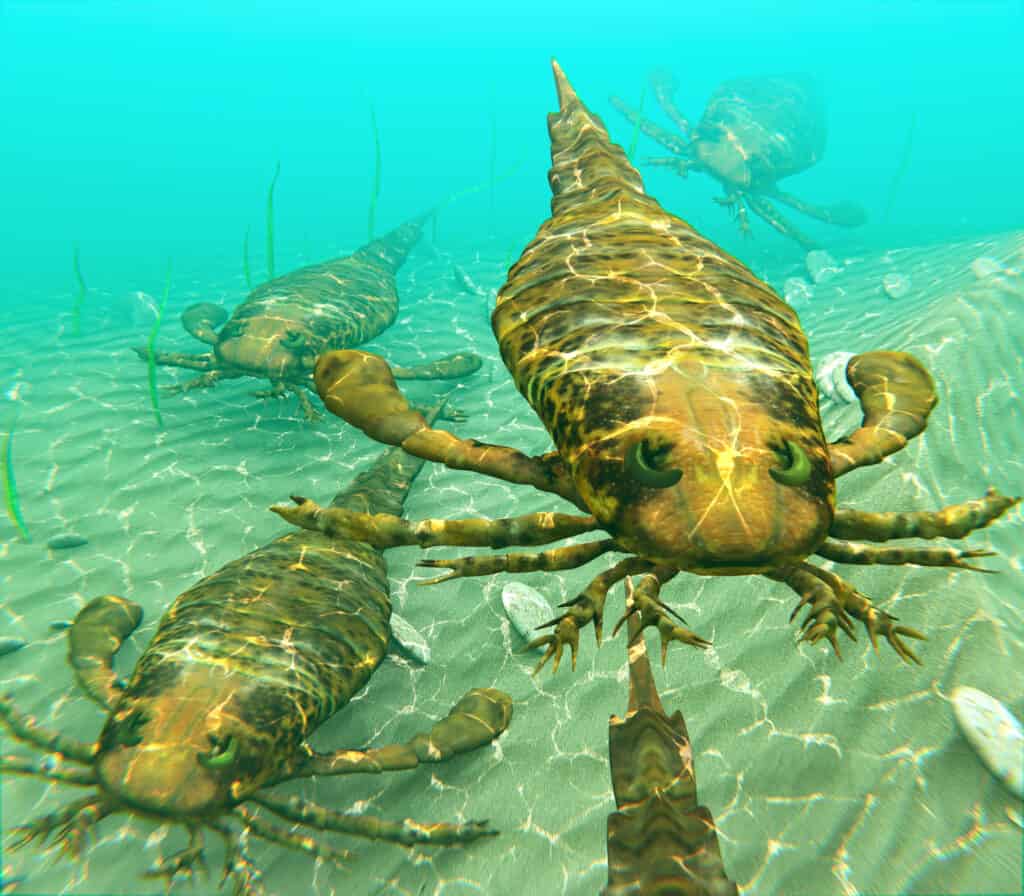
Sea scorpions were one of the main threats to the Cephalaspis.
©Aunt Spray/Shutterstock.com
Sea scorpions, also known as eurypterids, are a group of extinct arthropods that lived during the Paleozoic era, approximately 467 to 252 million years ago. They are the largest known arthropods to have ever lived, with some species reaching lengths of up to 8.2 feet (2.5 meters).
Eurypterids are often informally called sea scorpions due to their similarity in appearance to modern-day scorpions. However, they are not true scorpions, but rather an extinct group of aquatic arthropods that likely lived in both freshwater and marine environments.
Eurypterids had two main body parts: a cephalothorax (head) and a long, segmented body with a tail spine. They had large, compound eyes and several pairs of swimming legs that they likely used to move through the water.
Despite their large size, eurypterids were not top predators and likely fed on smaller prey such as fish and crustaceans. They went extinct at the end of the Paleozoic era, along with many other marine and terrestrial species.
10. Megalodon (Prehistoric Shark Species)

Megalodon close-up
©racksuz/Shutterstock.com
Megalodon was a prehistoric shark species that lived approximately 23 to 3.6 million years ago from the Early Miocene to the end of the Pliocene era. It is thought to be one of the largest and most powerful predators to have ever lived.
Megalodon was first discovered in the 19th century when large, triangular teeth were found in deposits around the world. Based on the size and shape of these teeth, scientists estimate that Megalodon was anywhere from 40 to 60 feet (12 to 18 meters) long, with some estimates suggesting it could have been even longer.
Megalodon is thought to have fed on a variety of marine animals, including whales, dolphins, and other large fish. Its teeth, which were up to 7 inches (18 centimeters) long, were designed for grasping and tearing apart large prey.
Despite its large size and fearsome reputation, Megalodon went extinct around 3.6 million years ago, possibly due to a combination of factors such as competition for food and changes in the ocean environment. However, the exact cause of its extinction remains a topic of debate among scientists.
In Conclusion
The sheer size of the ocean and the fact that it contains a wide range of different habitats, from the sunlit surface waters to the dark, cold depths of the abyssal zone gives the opportunity for so many fascinating creatures to be discovered. These different habitats provide a range of niches for different species to evolve and occupy.
The ocean is also constantly changing, with factors such as temperature, salinity, and nutrient levels varying widely in space and time. This has led to the evolution of an incredible range of adaptations and strategies that marine creatures use to survive and thrive in their environments.
Additionally, the ocean provides a wealth of opportunities for different types of feeding strategies, from filter feeding to predation. This allows for a diverse range of organisms to coexist in the same ecosystem without competing too heavily for resources.
Even though some of these creatures eventually die out, they are still worth exploring. Studying extinct sea creatures can help us to understand how our planet and the creatures within it have evolved over time. It can also help us to understand what we need to do to continue to help the vast biodiversity in our oceans thrive.
Overall, a combination of factors has led to the incredible diversity of marine life that we see today, and scientists are still working to fully understand and appreciate the full extent of this richness of biodiversity.
The photo featured at the top of this post is © Warpaint/Shutterstock.com
Thank you for reading! Have some feedback for us? Contact the AZ Animals editorial team.






